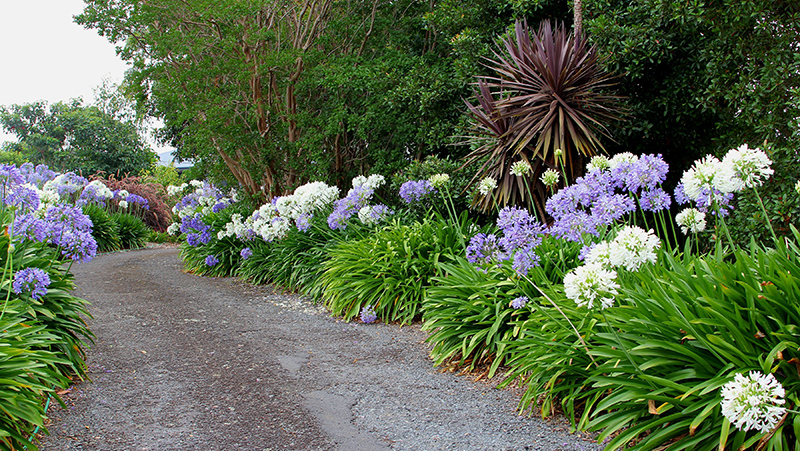Yates Account
Join now
Create a Yates account today!
Sign up to join the Yates Garden Club for monthly e-mails packed with seasonal inspiration, tips for success & exclusive promotions.
Plus if you’re a Garden Club member you can take part in the Yates Growing Community - a blog to share successes, get advice & win prizes in fun challenges along the way!

Forgot password
Enter the email address associated with your account, and we'll email you a new password.

Agapanthus (Agapanthus spp.) are very popular strappy leaved plants, not only for their lovely luscious light green leaves, but for their tall floral displays in summer. There are many varieties available, from white, mauve, blue, pink and even black. Great for border plantings, especially to soften harsh edging in the garden.
Larger forms can be quite weedy, especially if allowed to set seed. If you have these in your garden or would like to grow them, it's a good idea to remove the seed heads before they open.
How to grow Agapanthus in a garden
- Choose a full sun position with well drained soil.
- Enrich the soil with Yates Dynamic Lifter Organic Plant Food. If the soil is clay based, add gypsum and fork in well.
- Dig the planting hole twice as wide and to the same depth as the root-ball. Remove the plant from the container and gently tease the roots.
- Position in hole and backfill, gently firming down. Form a raised ring around the plant, creating a well so that water will go where it’s needed most. Water in well.
- Mulch with an organic mulch like woodchip or pea straw, keeping it away from the base of the plant.
- Water deeply, once or twice a week, depending on weather conditions.
- During the growing and flowering season feed with Yates Thrive Rose & Flower Granular Plant Food. TIP: for an added boost apply Yates Thrive Roses & Flowers Liquid Plant Food.

How to grow Agapanthus in a pot
- Choose a pot at least 350-500mm wide.
- Position in full sun to part shade and fill with quality potting mix, such as Yates Premium Potting Mix.
- Remove the plant from the container and gently tease the roots.
- Position in hole and backfill, gently firming down. Water in well.
- Water deeply, once or twice a week, depending on weather conditions.
- During the growing and flowering season, apply Yates Thrive Roses & Flowers Liquid Plant Food. Throughout the year apply Yates Thrive Fish Blood & Bone Plant Food Concentrate.
Growing tips
- To keep the plant looking its best, remove any of the older or damaged leaves.
- This plant can be easily propagated through division in late autumn to winter by carefully removing it from the ground or the pot. Gently shake off some of the soil so that you can see the roots and the individual plants. Carefully pull the individual plants apart making sure that each one retains its own roots. Do not break them into too many pieces - some may not have enough roots to survive on their own. Always discard old or weak pieces and only replant the young, healthy–looking ones.
- Remove spent flower heads to reduce risk of self seeding.
- Many of the new varieties on the market are sterile varieties. This reduces the spread of the seeds especially in bushland areas.
Orange trumpet vine, with its brilliant cascading masses of orange tubular flowers, is one of the most spectacular winter flowering climbers.
Spring Stars
Spring Stars are a versatile addition to any garden with delightful lavender-blue, star shaped blooms.
Flax
Flaxes (Phormium spp.) are highly versatile plants which don't mind swampy or dry conditions. Great for large pots or planted en-masse in garden beds.
Proteas
Not just any old blossom, protea flowers are blooms with attitude. If you can give them full sun and reasonable drainage, proteas will love you.
Recommended Products
Yates Thrive Rose & Flower Granular Plant Food
Specially formulated to grow all types of flowers. With high potassium for large & abundant flowers, added calcium & iron for stronger flowers.
Yates Thrive Roses & Flowers Liquid Plant Food
Provides your flowers & roses with the balanced nutrients they require for healthy growth and flower production.
Yates Dynamic Lifter Organic Plant Food
Releases nutrients slowly, improves the structure and moisture retention of the soil and encourages earthworms and beneficial soil micro-organisms.
Yates Premium Potting Mix
A premium potting mix, ideal for all potted plants and shrubs, including ornamentals, fruit trees, vegies and herbs.
















Share
Share this article on social media